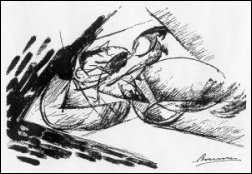FRONT PAGE
CONTACTS |
Mark Tatham - RESEARCH PROFILE
 |
Dynamic Force of the Cyclist,
ca. 1914 by Umberto Boccioni [1882-1916], from the collection
of the University of Michigan Museum of Art. Lithograph: h. 29.5cm,
w. 38.4cm.
|
[key words:
'speech production', 'speech perception', phonology, prosodics, phonetics,
'cognitive phonetics', acoustics, linguistics, expression]
RESEARCH INTEREST
I am basically interested in how speakers formulate
plans for what they want to say, and how listeners work these out from the
waveforms produced by speakers. The research area
therefore covers the theory of both speech production and speech
perception, and focuses on the development of plausible models which help
elucidate and explain speech as a key human behaviour. These models must
be testable, and to this end I have tried to concentrate on fully explicit
computational models which can be experimented with to see if they are
capable of adequately simulating aspects of speech production and
perception. Current work focuses on characterising some aspects of prosody
- especially rhythm and intonation; cognitive management of phonetic
processes; mapping the relationship between production and perception
processes and the acoustic signal; how speakers communicate expressive
content and how listeners perceive it.
RESEARCH HISTORY
- My EARLY
work tried to cast some light on speech motor control
using the then new experimental techniques of electromyography and air
pressure detection and measurement. The data and conclusions from these
experiments fed into theoretical considerations of the relationship
between phonological objects and processes and their phonetic
correlates. The experimental paradigm adopted was essentially the
'physical correlates' paradigm which seeks to set up formal
relationships between abstract characterisations and physical
measurements. Many of the
early publications have been re-issued in web format.
- I developed the Theory of Cognitive Phonetics in the late 1970s and
early 1980s. This arose from a clear gap in the theory. The 1960s had seen the development of Coarticulation Theory, and
indeed Kate and I played a
role in its development, but the theory was too keen to stress how the
continuousness of articulation and its subsequent aerodynamics and
acoustics were explained by simple physical inertial and other effects.
There was clearly an additional factor entering into phonetics:
cognitively sourced control exercised over these physical effects. This
cognitive intervention was different in type from phonological processes,
and merited an explanation within phonetic theory.
Cognitive Phonetic Theory included characterisations of the appropriate
motor control mechanisms which would permit cognitive intervention in
otherwise mechanically dominated (involuntary) physical processes.
- A refinement of
Cognitive Phonetics was introduced in the 1990s: cognitive intervention
was refined to include a characterisation of the monitoring and
supervision of phonetic processes. Phonetic rendering of phonological
plans was now seen as a managed process, not a process started
and left to its own devices. Phonetics, hitherto considered automatic,
is seen as having an active element acting both managerially and as a
means of stabilising production processes. Management is carried out by
the Cognitive Phonetic Agent. These ideas have been extended our
current paper:
- Tatham, M. and
Morton, K. (2003 forthcoming) Data structures in speech
production. Journal of the International Phonetics Association
33:1.
- From the late 1980s
for a decade I was involved in the development of SPRUCE - a
computational implementation of much of the phonetic theory Kate and I
had developed earlier. The implementation was expressly designed to test
our models, and to that end has proved highly successful. The
development of SPRUCE was a joint project with Eric Lewis in the
Computer Science Department at the University of Bristol. This decade
saw a large number of publications in the area of
computational modelling of speech production processes.
- Recently, with
Katherine Morton, I have turned again to concentrate more on the development
of theory. Our current (post 1997) publications reflect this as well as
bringing out more of the substantive detail of the SPRUCE project
following the release of the IPR by Essex University in 1998. Kate and I have
two books in preparation which focus on an account of how speech
communicates expression - especially emotional content. Kate's
bio-psychology background was fundamental in initiating this work, and
we have now incorporated this into our general cognitive theory. Key
publications here are
the 2003 JIPA paper which concentrates on an XML formalism for data
structures in phonetics, the
2004 OUP book
on expression in natural and synthetic speech, and the
2005 Wiley
book on our development of high-level synthesis.
 |
Those who know
me know of my enduring obsession with high speed road cycling. This
image by Umberto Boccioni says it all.
|
|